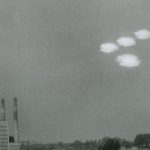 Technology
Technology  Technology
Technology  Humans
Humans 10 Everyday Human Behaviors That Are Actually Survival Instincts
 Animals
Animals 10 Animals That Humiliated and Harmed Historical Leaders
 History
History 10 Most Influential Protests in Modern History
 Creepy
Creepy 10 More Representations of Death from Myth, Legend, and Folktale
 Technology
Technology 10 Scientific Breakthroughs of 2025 That’ll Change Everything
 Our World
Our World 10 Ways Icelandic Culture Makes Other Countries Look Boring
 Misconceptions
Misconceptions 10 Common Misconceptions About the Victorian Era
 Mysteries
Mysteries 10 Strange Unexplained Mysteries of 2025
 Miscellaneous
Miscellaneous 10 of History’s Most Bell-Ringing Finishing Moves
 Technology
Technology Top 10 Everyday Tech Buzzwords That Hide a Darker Past
 Humans
Humans 10 Everyday Human Behaviors That Are Actually Survival Instincts
 Animals
Animals 10 Animals That Humiliated and Harmed Historical Leaders
Who's Behind Listverse?

Jamie Frater
Head Editor
Jamie founded Listverse due to an insatiable desire to share fascinating, obscure, and bizarre facts. He has been a guest speaker on numerous national radio and television stations and is a five time published author.
More About Us History
History 10 Most Influential Protests in Modern History
 Creepy
Creepy 10 More Representations of Death from Myth, Legend, and Folktale
 Technology
Technology 10 Scientific Breakthroughs of 2025 That’ll Change Everything
 Our World
Our World 10 Ways Icelandic Culture Makes Other Countries Look Boring
 Misconceptions
Misconceptions 10 Common Misconceptions About the Victorian Era
 Mysteries
Mysteries 10 Strange Unexplained Mysteries of 2025
 Miscellaneous
Miscellaneous 10 of History’s Most Bell-Ringing Finishing Moves
10 Amazing Valentine’s Day-Themed Space Phenomena
Valentine’s Day is a day for celebrating love, but it doesn’t have to be the love between romantic partners. It can be the tenderness you feel for a beloved pet, commemorated with a piece of steak or cheese.
It can also be the love of space and all the amazing things found in our universe. So, because some saints (fun fact: there may have been three different Saint Valentines) were martyred over one thousand years ago, please enjoy this article about diamonds, flowers, chocolate, and beating hearts in the sky!
Related: Top 10 Frightening Facts About Our Solar System
10 A Dead Star Transforming into a Diamond the Size of a Moon
A diamond the size of a moon would be a perfect Valentine’s gift, but that’s surely the stuff of fiction. Right? Apparently not, because when stars like our Sun die, they may crystallize and turn into gigantic celestial diamonds.
Instead of exploding, stars like the Sun will puff up, engulf the inner planets, then lose their outer layers and leave behind a super-dense core. Those made of mostly metallic carbon and oxygen will cool and crystallize into moon-sized diamonds. And the dead star HD 190412 C, just 104 light-years away, is doing just that.
It may be a bit too early in universal time to observe a fully-fledged moon diamond, but the star in question should become one of these divine gems once it cools from its current 11,420 degrees. Just give it a quadrillion years or so.[1]
9 A Supernova “Blooming” Like a Flower
Supernova remnants, the exploded guts of a blown-up star, can be unsurprisingly hot and energetic, producing amazing images in infrared (heat) and X-rays. One particularly picturesque supernova remnant, known as G299, shines and “blooms like a cosmic flower,” says NASA.
The floral appearance betrays the fact that these types of supernovae are supposed to be more symmetrical. Known as Type Ia supernovae, they occur from an orbital dance between two stars. Technically, one is a zombie star, or white dwarf, which is the corpse of a Sun-like star—and our own stellar future.
The white dwarf is closely orbited by a companion star, from which the white dwarf steals material via gravitational attraction. As the white dwarf sucks more and more material from its partner, its mass grows. Once it hits a threshold, it blows up or basically dies again (remember it was already a corpse), though this time in a more explosively spectacular fashion.[2]
8 Pluto’s “Heartbeat”
When New Horizons arrived at Pluto in 2015, the little (in size, not importance) dwarf planet welcomed us with a heartfelt greeting. Literally, a frosty-white, heart-like feature known as Tombaugh Regio.
It was a remarkable discovery that captivated the global populace. Plus, it helped prove that Pluto was alive, with a sparse atmosphere of nitrogen, which predominates our own air. In frozen form, the nitrogen also helps form Pluto’s heart and drive its winds through a planetary “heartbeat.”
During the daytime, a thin nitrogen layer warms and turns into vapor. At night, it chills and condenses back into ice. This creates Pluto’s “heartbeat,” pumping nitrogen winds around its surface. However, the circulating air is 100,000 times thinner than on Earth.
Still, this process moves material and heat around Pluto while sculpting some of its breathtaking, chaotic, and unexpectedly varied terrain. Seriously, such a small and presumably dead world is shockingly lively.[3]
7 Two Stars Embrace in the Face of Doom
Binary star systems are discovered all the time, all over the night sky. Yet, in a first-of-its-kind discovery, astronomers have found a pair of stars on the outskirts of a supermassive black hole. As a bonus, it’s our black hole!
Even on the precipice of doom, these two stars are safely (for the cosmic moment) locked in each other’s embrace as they’re spiraling around Sagittarius A*, pronounced “A star.” The pair is collectively called D9, with an estimated age of 2.7 million years—compare that to the 4.5 billion-year age of our Sun.
The D9 system has a more Valentine’s worthy fate than one would expect: The gravitational force of the black hole will cause the pair to merge into a single star, together for all eternity. Until it gets destroyed, that is.
This finding is groundbreaking for multiple reasons. It shows that binaries can exist near supermassive black holes, and stars can be born in these energetic environments. Also, the binary will only last another million years before merging, meaning it’s extremely rare to catch something so short-lived on cosmic timescales.[4]
6 A Beautiful Martian “Flower”
Martian rovers like Curiosity have gifted us treasure troves of science, awe, and inspiration. As an example of the latter, images from Mars constantly include pareidolia or wishful thinking, like Bigfoot on Mars, and multiple supposed alien skulls.
Scientists have also discovered a common Valentine’s Day gift, a lovely little flower many would gladly receive. Too bad it was just a rock discovered during Curiosity’s 3,396th day on the red planet; a Martian day is called a “sol” and it’s about 40 minutes longer than an Earth day.
But wait, the rock does hold the promise of something special, Martian life, because it was created by flowing, mineral-laden water in the ancient past.[5]
5 A Pink Planet
Every year around Valentine’s Day, the candy aisles turn red and pink. Planets also come in a variety of colors. Accordingly, the previous two sentences are more related than one would think because scientists spotted a planet that’s pink.
Located around 57 light-years away, the planet is called GJ 504b, and it orbits a star named GJ 504. The star is like our Sun except a bit hotter. It’s also visible with the unaided eye, though faintly, in the Virgo constellation. But most interesting is its pinkish planet, which glows in a “dark cherry blossom” or a dull magenta.
This chromatic standout shines with the heat of its creation, born just 160 million years ago. And it’s pretty big: about Jupiter-sized but with four times the mass of our own gas giant.[6]
4 Chocolate in Deep Space?!
Chocolates are a favorite gift, and if the previous pink planet seemed unlikely, research from the University of Hawai’i sounds even wilder: chocolate-flavor molecules in deep space. The research, which is totally real, explored how interstellar ice gets bombarded by galactic radiation. When it does, it could create three molecules that “contribute to the taste and flavor of chocolate.”
One of these molecules was previously and “tentatively” detected in space. Additionally, these substances can easily form at frigid temperatures as low as -450°F (-267.8°C) in cosmic clouds of gas and dust (the building blocks of stars and planets). The molecules—propanol and butanal—can then serve as the building blocks for more complex compounds that are essential for the emergence of life. No argument there; Chocolate is definitely good for life![7]
3 Some Rogue Planets Are All Alone (but Together)
Imagine how lonely it must be for rogue planets, which have been flung far from their solar systems, to eternally wander alone through space.
In a somewhat romantic twist, some rogue planets have partners, meaning that two gravitationally bound planets are together in space. Though exiled to wander the dark wastes of the cosmos, at least they have each other. It’s not a one-off. Of 540 “free-floating planetary-mass objects” found within the Orion Nebula, about 40 of them are binary planets without a star to orbit.
Other than the possibility of being flung from their stellar parents, some of these rogue binaries may be born in the dark, birthed by gas and dust clouds far from any stars. On a sad note, once they lose the heat of their birth, they’ll be invisible to us.
But on a potentially happy note, it’s possible that they’ll eventually find a star to orbit. Or maybe a black hole or other massive object. However, this may mean that they get split up by the gravity of whatever massive object they encounter. Sorry for the emotional rollercoaster.[8]
2 Baby Stars Born as a “String of Pearls”
When galaxies “smash” into each other, it’s unlikely that any stars or planets will actually crash together. The interaction is closer to a dance than a violent mass collision.
New gravity interactions may throw things about as they get close to each other, but these immense events also create new generations of stars. And, ostensibly, batches of planets host exciting wonders, like the emergence of life, perhaps.
Another common feature is the formation of tadpole-like “tidal tails” that can stretch thousands (or more) light-years. As interacting galaxies gravitationally tug on each other, they pull out long streams of gas and dust. Within these streams, infant stars form in their millions. These tidal tails may contain hundreds of clusters, and each cluster may have a million young, broiling blue stars.
If not for galactic collisions, the star-forming dust in the galaxies would have remained inert. But the gravitational shake-up causes gas pockets to compress, igniting a “firestorm of star birth” as in this image of the galaxy mashup called Arp-Madore 1054-325.[9]
1 Galaxies Form a Cosmic Rose
The mundanely named Arp 273 belies its picturesque form. Captured for Hubble’s 21st anniversary in April 2011, Arp 273 is like a cosmic rose formed by interacting galaxies.
UGC 1810 is the top galaxy, with a disk that’s being gravitationally distorted by the galaxy on the bottom, UGC 1813. Across the top, a scintillating “swath of blue jewels” displays something more precious than any gem: the combined, dazzling light from clusters of insanely hot and bright young stars, blazing a brilliant blue.
The smaller of the galaxies, viewed nearly edge-on in one image, has a bright glowing nucleus where new stars are being born. As just mentioned, though galaxy collisions may sound catastrophic, they trigger the birth of many new stars by smooshing gas together and compressing it. This wouldn’t be the first time the gift of a rose or jewels has led to a birth.[10]








